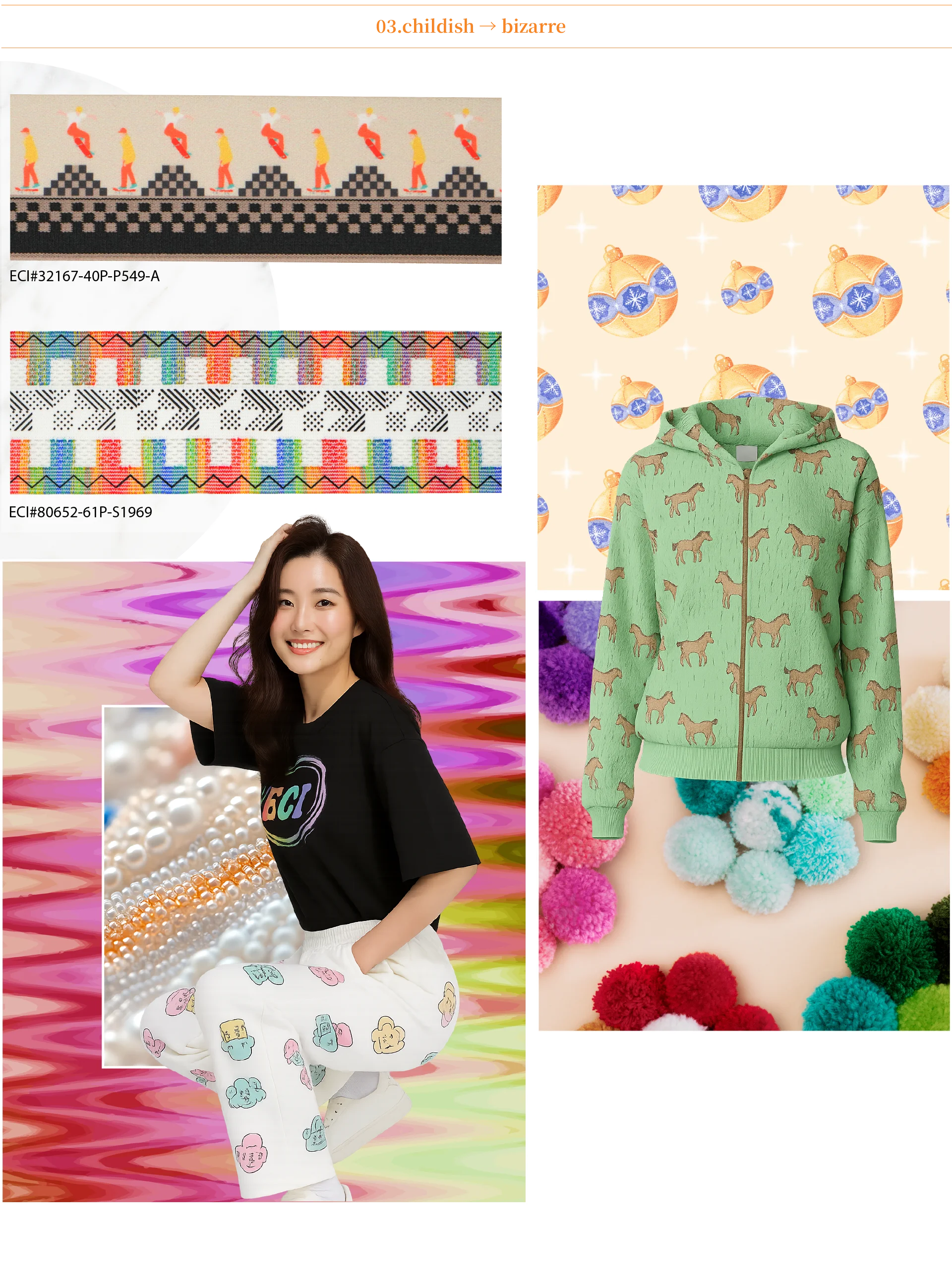Autumn/Winter 2026/27 Fashion Trends: Push Sensation
In a world craving powerful, unforgettable experiences, contemporary consumers are seeking equilibrium between spectacle and authentic meaning, reconnecting with real life while exploring beyond reality. This longing shapes the evolution of fashion, urging us to break from the mundane and embrace a life filled with adventure, imagination, and sensory richness.
The Autumn/Winter 2026/27 fashion trends under the theme PUSH SENSATION reveal four transformative directional shifts that paint a sensory revolution for the AW26 season:
gentle → raw – returning to nature and tactility
classic → theatrical – releasing dramatic luxury
childish → bizarre – challenging norms and perception
pragmatic → dreamlike – merging technology with fantasy
Together, these AW26 fashion trends celebrate authenticity, break boundaries, and invite us to experience fashion as a form of personal expression and emotional connection. Let's explore what's shaping fashion trends 2026 across textiles, colors, and design directions.

01 gentle → raw: Autumn Winter 2026 Sustainable Fashion Trends
Fashion is returning to its roots, embracing earthy, nature-inspired aesthetics that blend soft elegance with handcrafted rugged textures. This AW26 trend celebrates slow fashion, sustainability, and authenticity through plant dyeing, organic fibers, and regenerated materials. It's about honoring the beauty of imperfection, expressing resilience through understated design, and reconnecting with the tactile, grounding qualities of natural materials.
The gentle → raw direction represents one of the strongest sustainable fashion trends 2026, reflecting consumer demand for eco-conscious textiles and transparent production methods.
Color Palette: AW26 Earth Tones
Mineral and earth hues dominate, accented with vibrant natural pigment tones that define fall winter 2026 color trends.
PANTONE: 12-5202 / 15-1306 / 14-0721 / 18-0422 / 18-0832 / 18-0935 / 19-5917 / 19-1241 / 19-1111 / 19-1761 / 17-6229

Key Materials for Autumn 2026
Organic fibers and artisanal craftsmanship / Plant-dyed textiles / Eco-fur / Animal hair / Double-sided suede / Bouclé knits / Brushed mohair / Rare hair yarns (alpaca, cashmere, mohair) / Rustic tweed / Irregular basket weave & handloom textures / Fine worsted twill / Traditional plant dyes (madder, persimmon brown) / Uneven corduroy / Cotton flannel / Soft coarse cotton / Pigment-dyed fleece / Textural surfaces / Fiber-felting effects / Crinkled textures / Faded & worn-in finishes
Prints & Patterns
Traditional ethnic craftsmanship / Nature-driven art / Mineral and stone textures / Tribal influences (Kilim motifs) / African mud-dye and walnut-stained ombré designs
Featured Styles: AW26 Textile Innovation
1.Earth's Architecture
ECI#32101-35P – A mineral-tone Y-shaped waistband tape featuring orderly geometric textures that balance nature and craftsmanship. Subtle earthy tones express humble yet authentic tactile beauty, perfect for structured silhouettes with organic sensibility.
2. Regenerated Beauty
ECI#72160-42R – A recycled mélange waistband tape interwoven with green and black reclaimed yarns, embodying natural regeneration aesthetics. Waste yarns are reborn through innovation, expressing sustainability without compromising style—a key example of eco fashion trends 2026.

02 classic → theatrical: Fall 2026 Luxury Fashion Trends
This direction celebrates the transformation of classic materials into bold, theatrical statements. Traditional fabrics like tweed, Shetland wool, and alpaca are reimagined alongside luxurious velvets, dramatic metallics, and unconventional textures. It's about breaking singular rules, embracing personalized subversive aesthetics, and pushing the boundaries of beauty through opulence, creativity, and fearless self-expression.
The classic → theatrical trend reflects AW26 runway trends seen across major fashion weeks, where designers are amplifying drama and maximalist aesthetics.
Color Palette: AW26 Dramatic Hues
Soft neutrals meet intense reds and refined blue-greens, accented with metallic copper—defining winter 2026 color trends.
PANTONE: 16-0213 / 16-1526 / 17-5111 / 14-0837 / 16-1356 / 18-1564 / 19-1531 / 19-1718 / 19-4726 / 19-0315 / 18-1537

Key Materials for Winter 2026
Classic meets dramatic: Shetland wool / Tweed / Alpaca / Mohair plaids / Suiting fabrics / Club stripes / Herringbone / Twill / Glossy leather / Laser-cut finishes / Embellished surfaces / Faille / Crushed organza / Mini jacquard / Velvet / Burn-out velvet / Jacquard / Satin / Chiffon / Shantung / Sequins / Baroque-inspired brocades / Metallic brocade
Prints & Patterns
Retro geometry meets lavish ornamental motifs / Checks and tonal checks / Undulating wave patterns / Retro-modern geometric compositions / Furniture-inspired florals / Decorative wallpaper styles
Featured Styles: Luxury AW26 Design
1.Contrast Luxury
ECI#9A494-30 – A waistband tape featuring high-contrast black-and-white checkerboard motifs paired with a subtle sheen, delivering luxurious dramatic visual impact. Perfect for structured garments that demand attention in fall winter 2026 fashion.
2.Layered Elegance
ECI#3V005-15 – A velvet back-neck tape in misty apricot, layered with deep-purple striping. This refined combination expresses elegant sophistication with theatrical tension—ideal for adding unexpected luxury to necklines and finishing details.

03 childish → bizarre: AW26 Creative Fashion Trends
Merging childlike innocence with surrealist vocabulary, this theme blends playful modernism with global cultural imprints and unexpected artistic expressions. Designers adopt tribal-inspired eclectic imagery and dreamlike compositions, resulting in highly personalized aesthetic statements. This duality brings emotional escapism, celebrates the joy of self-expression, and invites us to see fashion as a canvas for imagination and cultural storytelling.
The childish → bizarre direction represents bold fashion predictions 2026, where creativity and individuality take center stage.
Color Palette: AW26 Playful Tones
Soft playful pastels juxtaposed with bold, unexpected accent tones.
PANTONE: 12-1010 / 14-2710 / 14-5711 / 12-0721 / 15-1239 / 15-5534 / 15-2216 / 16-1544 / 18-4247 / 16-0948 / 18-6320

Key Materials for Autumn Winter 2026
Minimal yet unconventional: Playful faux furs / Puffy wool knits / Bio-based PVC coatings (glossy or matte) / Coated wovens / Dense wool / Felt / Bonded fabrics / Double knits/wovens / Handcrafted knits / Crochet patchwork / Intarsia jacquard / Checks and grid patterns / Sequins / Hand embroidery / DIY aesthetics / Beaded tulle / Dotted jacquard / Satin stripes
Prints & Patterns
From cute to globally expressive: Cartoon graphics / Bold geometry / Puzzle motifs / Psychedelic imagery / Cultural and tribal patterns
Featured Styles: Bold AW26 Apparel Trends
1.Urban Energy
ECI#32167-40P-P549-A – Heat-transfer elastic featuring skateboarding cartoon characters combined with bold staircase geometry and checkerboard details. Vibrant color blocks and dynamic rhythm create a playful, energetic visual universe—perfect for streetwear and youth-focused collections reflecting 2026 style trends.
2.Tribal Expression
ECI#80652-61P-S1969 – Bold geometric construction inspired by tribal motifs. Contrasting colors, lines, and shapes generate a playful yet tension-filled expressive identity that celebrates global cultural influences and individual storytelling.

04 pragmatic → dreamlike: Tech Fashion Trends 2026
This narrative merges precise tailoring with futuristic innovation, delivering high fashion that balances functionality with striking visual impact. Sharp structures meet durable materials and tech-forward fabrics, accented with airy hues and metallic finishes. It appeals to consumers seeking the intersection of structure, innovation, and beauty—creating breakthrough visual experiences that feel both practical and otherworldly.
The pragmatic → dreamlike trend aligns with tech fashion trends 2026 and fashion innovation 2026, where performance meets aesthetics.
Color Palette: AW26 Futuristic Hues
Cosmic darks paired with hazy pale tones, accented with metallic silver—representing forward-thinking AW26 color trends.
PANTONE: 19-4025 / 19-3316 / 19-4914 / 19-3642 / 19-3955 / 14-0846 / 14-5002 / 14-4206 / 12-0000 / 12-0108 / 11-0602

Key Materials: Fashion Forward 2026
Technology meets rarity: Ultrafine combed wool / Elastic fabrics / Irregular printed wool / Subtle embossed textures / Micro-textured surfaces / Refined jacquard / Glossy/matte finishes / 3D raised surfaces / Burn-out velvet / Lustrous satin / Rainbow brocade / Reflective taffeta / Cloud-pattern brocade / Translucent chiffon / Organza / Pleats / Fluid knits / Modern cocoon wool / 3D bubble fabrics / High-tech down fills / Handcrafted 3D knits / Neo-era textiles / Compact sweatshirting / Dense pile fabrics
Prints & Patterns
From cosmic inspiration to minimal abstraction: Interstellar vibrations / Meteor textures / Gradients / Abstract negative space / Minimal botanical line art / Simple linear sketches
Featured Styles: Performance AW26 Materials
1.Performance Glow
ECI#79013-53P – A functional mesh-structured waistband expressing lightness and breathability. A vivid lime gradient adds soft dreamlike luminosity—balancing athletic performance with aesthetic appeal for activewear and future-forward designs in apparel trends 2026.
2.Safety Redefined
ECI#31541-30P-RT – A reflective binding tape featuring bright orange and crisp white dual-color contrast. Reflective properties enhance visibility and safety while delivering strong, recognizable design identity—perfect for urban outdoor wear and functional fashion.
Key Takeaways: AW26 Fashion Trends 2026/27
The Autumn Winter 2026/27 fashion trends invite us to push sensation, to feel deeply, express boldly, and embrace the transformative power of fashion. From gentle → raw authenticity and sustainable materials to classic → theatrical drama, from childish → bizarre imagination to pragmatic → dreamlike innovation, these AW26 trends celebrate the full spectrum of human experience and creative possibility.
Whether you're a designer, textile manufacturer, or fashion brand looking ahead to the fall winter 2026 season, these fashion trend forecasts provide actionable insights into colors, materials, and design directions shaping the industry.
Ready to incorporate these AW26 fashion trends into your next collection? Explore ECI Elastic's innovative narrow fabric solutions that bring these trends to life with precision engineering and sustainable practices.
Reference: Intertextile Shanghai Apparel Fabrics




